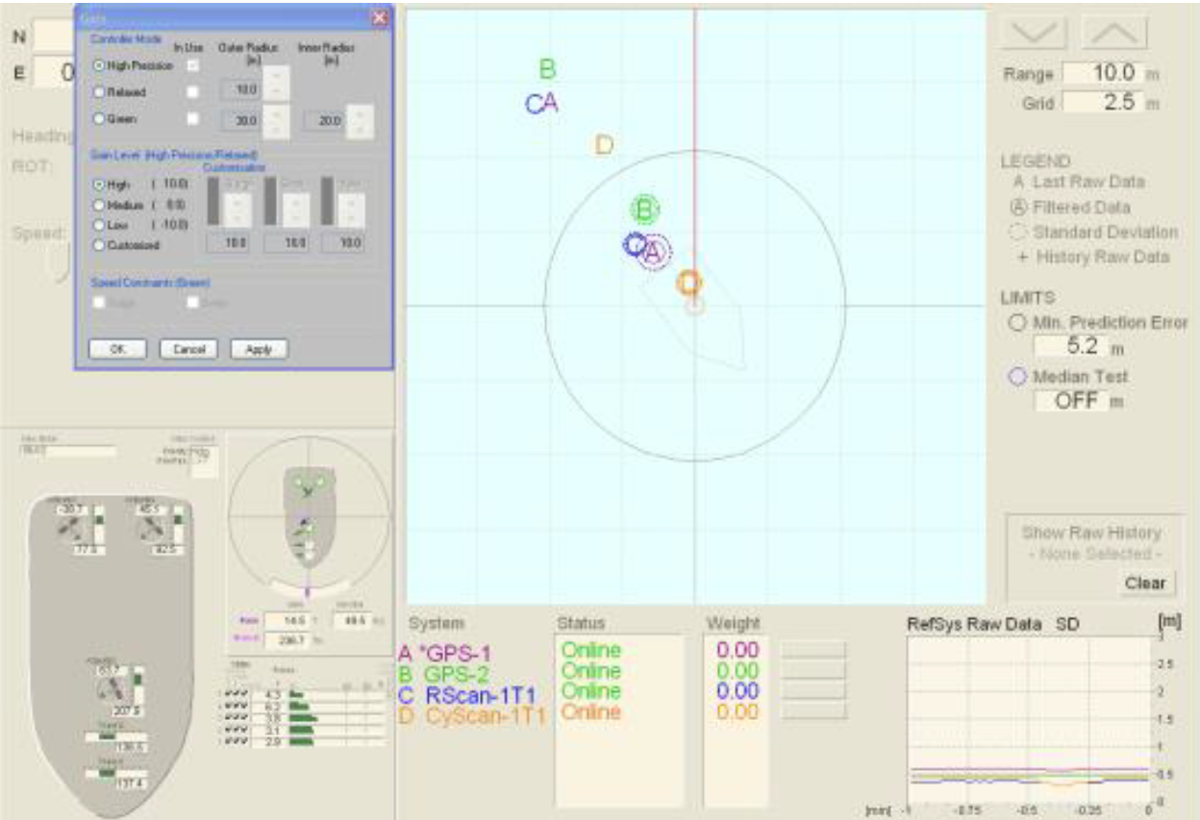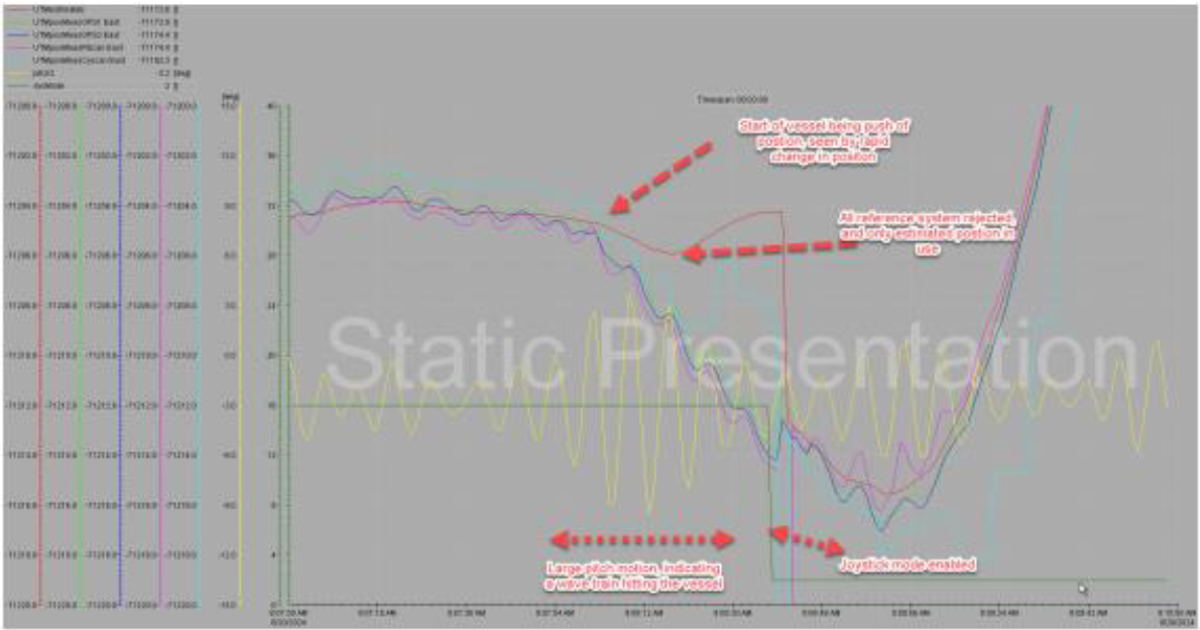There – but not really there
- DP Event
- Published on 5 November 2024
- Generated on 16 December 2025
- DPE 03/24
- 4 minute read
Incident
Jump to:
This DP event occurred on a DP equipment class two supply vessel whilst carrying out cargo operations on the starboard side alongside the asset and working at the lee side in the drift-off position.
1. Overview
The supply vessel was operating with two DGNSS, one radar-based and one laser-based reference system accepted into the DP system.
2. What happened?
The vessel was operating in poor weather conditions and experiencing wind and waves on the starboard bow, with a heavy swell of 3.2m and around 28 knots average wind. The vessel had been experiencing position excursions of around 3-5m quite frequently and also heading was dropping around 3-5 degrees when losing position.
As the vessel was working on the drift-off (lee-side), the Master and DPOs considered this acceptable.
At 10:08, when the vessel's position and heading deteriorated with around 2 metres and 2 degrees excursion, out-of-limit warnings were generated. Over the following couple of seconds, one by one, prediction error alarms for each of the reference systems were generated but not fully realised by the DPO.
The vessel commenced drifting aft and losing its heading due to the wind and waves. The DPO was monitoring the operator station and awaiting the thrusters to react and start thrusting to return to position; however, the vessel continued moving further away from position. On the operator station, the DPO reported that the reference systems were still appearing to be online, though the weighting was not clarified.
When the vessel's speed began increasing away from the asset, the DPO disengaged sway and surge to take control on DP joystick, at which point, a position dropout alarm was triggered due to no reference systems accepted into the system. The DPO manoeuvred the vessel away from the asset on the DP joystick and out of the 500m zone.

Figure 2 – Screenshot to show difference exceeding 5 m
3. Findings
Investigation of the event concluded that:
- Due to only one line of DP alarms being visible at a time on the operator station screen, the DPO did not visually see the reference prediction error alarms activated. When many alarms activate in a short period, the second DP operator station must be used to show the full alarm list.
- Multiple rapid alarms had been accepted, and the alarm drop-down had not been expanded to check entirely those activated. If they had, it would have been realised that the ‘No reference system’ alarm had been activated and that the system was using the estimated position only.
- From analysis of the DP system history, it was seen that the vessel was hit by a wave train. The wave train's effect is that the position reference systems' measure position is moving away from the estimated position.

Figure 3 – History analysis
- The wave train hit the vessel, and this ‘unknown external force’ pushed the vessel rapidly out of position, causing deviation between the measured position (reference systems) and the estimated position (model position). The deviation exceeded the prediction error limits of 5 m and caused all reference systems to be rejected.
- The DP software version onboard the vessel had a known weakness regarding position drop out of the DP reference systems during rapid movements caused by wave trains/ several waves in a row.
4. Conclusion
Following analysis of the event from the DP manufacturer, the cause was identified. The vessel was able to continue DP operations, with limitations, until the DP software could be upgraded to a higher version that had implemented improvements to handle the model error.
In cases like the one described above, if all reference systems are rejected, there are three potential actions to be taken.
- Enter joystick mode to control the vessel and regain position.
- Re-calibrate all reference systems.
- Wait 30 seconds for position dropout to be reported, and the reference system will automatically calibrate.
With the vessel's movement in this case study, the vessel crew made a valid choice of entering joystick mode to regain position.
Latest DP incidents
-
Always be prepared – Erroneous relative GPS heading input jeopardises follow target operations
Always be prepared – Erroneous relative GPS heading input jeopardises follow target operations
DPE 02/25
1 August 2025
Incident
-
Printer compatibility
This undesired event occurred on a DP Class 3 drillship, whilst operating in open bus configuration and undertaking drilling operations.
DPE 02/25
1 August 2025
Undesired event
-
Inadvertent act causes loss of DP, once again!
While vessel was recovering scrap metal using an ROV and crane, an alarm was triggered, but the DPO could not silence it
DPE 02/25
1 August 2025
Incident
-
Beware the solitons
An equipment class 2 pipelay vessel was engaged in pipelay operations in an area known for solitons
DPE 02/25
1 August 2025
Undesired event
-
DP drill scenario
DP emergency drill scenarios are included to assist DP vessel management and DPOs / Engineers and ETOs to conduct DP drills onboard.
DPE 02/25
1 August 2025
Drill Scenario
The case studies and observations above have been compiled from information received by IMCA. All vessel, client, and operational data has been removed from the narrative to ensure anonymity. Case studies are not intended as guidance on the safe conduct of operations, but rather to assist vessel managers, DP operators, and technical crew.
IMCA makes every effort to ensure both the accuracy and reliability of the information, but it is not liable for any guidance and/or recommendation and/or statement herein contained.
Any queries should be directed to DP team at IMCA. Share your DP incidents with IMCA online. Sign-up to receive DP event bulletins straight to your email.